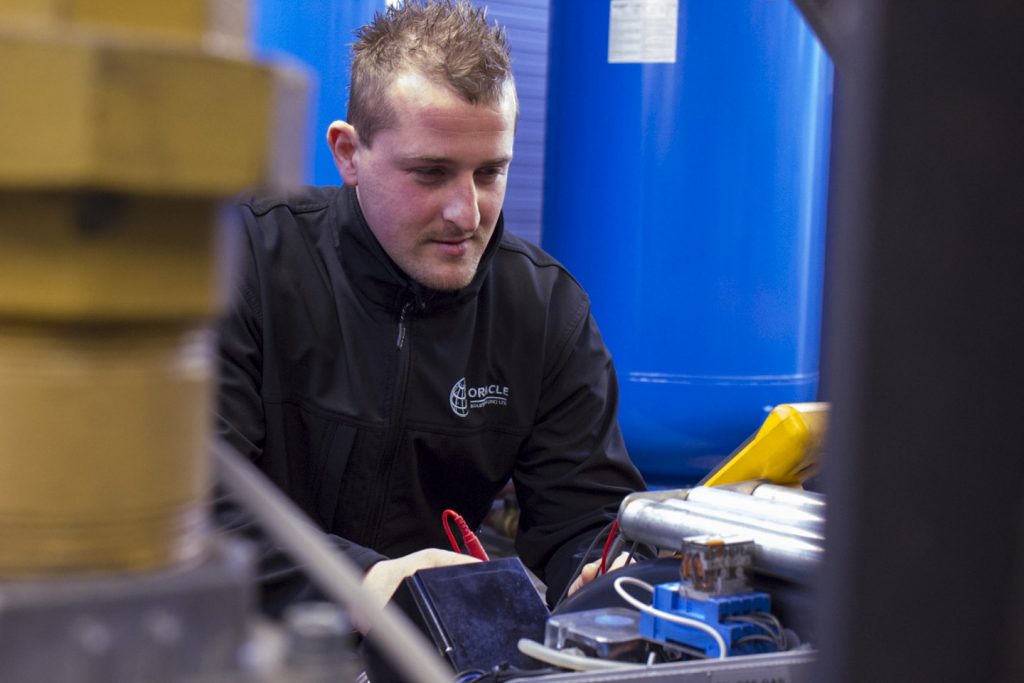What equipment is used for asbestos air testing and monitoring?
Asbestos air testing and monitoring is hugely important across a wide range of buildings and workplaces for both safety and regulatory reasons. The basic process involves capturing a sample of the air in a particular location, followed by analysis of the sample under a microscope. This procedure enables analysts to ascertain the concentration of asbestos fibres in the air at the given location.
However, if you are reading this, you might be unsure of the specific equipment that is used to carry out asbestos air testing and monitoring. Below, then, we have provided a detailed overview.

Importance of asbestos air testing
Today, it is well-known just how dangerous asbestos can be to human health. The naturally occurring fibrous silicate mineral was first commercially mined in the mid-19th century, and went on to be extensively used as a construction material for much of the 20th century.
Only in late 1999 did the UK Government finally impose a total ban on the importation and use of all forms of asbestos. By this stage, it was clear that the inhalation or ingestion of the substance heightened the risk of developing such potentially fatal diseases as mesothelioma and asbestos-related lung cancer. Indeed, around 5,000 people a year in the UK die from asbestos-related diseases, even in the 2020s.
Unsurprisingly, then, stringent regulations now apply in the UK to how the risks from asbestos are managed. Regulation 19 of the Control of Asbestos Regulations 2012 (CAR 2012) – the overarching asbestos legislation in the UK – stipulates that employers must arrange regular monitoring of airborne fibres, in addition to keeping records of the results.
In practice, there is a variety of scenarios in which an employer might arrange for asbestos air testing and monitoring to be carried out. These include:
- Prior to asbestos abatement work, such as encapsulation and/or removal of asbestos-containing materials (ACMs)
- During the abatement process
- Post-abatement
- Routine checks
- Emergency situations – for example, if ACMs are accidentally disturbed, and the employer wishes to determine the level of asbestos fibres that has been released into the air as a result.
Types of asbestos air sampling
There are important distinctions to be made between different types of asbestos air monitoring and sampling:
- Personal sampling, sometimes referred to as “personal air testing”, involves air testing being undertaken on a specific person. The aim is to monitor the personal air that the given individual is breathing in during an activity where asbestos may be involved. Personal sampling can be crucial for ascertaining whether any control measures implemented nearby are working well in keeping the given person safe.
- Area sampling is the other broad form of asbestos air monitoring and testing; it focuses on measuring the concentrations of asbestos present in a particular area, instead of focusing on one person. This might take the form of, for example, background sampling to establish the prevailing asbestos fibre concentration, or leakage air testing. The latter is carried out directly outside of an asbestos removal enclosure to ascertain the effectiveness of control measures in this part of the workplace.
A variety of sampling techniques are also associated with the asbestos air testing and monitoring process. These include:
- Phase contrast microscopy, or PCM, is the standard method used by which fibres in the air can be sampled and counted. It involves air being drawn at a known flow rate through a filter for a measured time, in order to collect airborne particles. The filter is then mounted on a glass slide for microscopy examination, so that fibres can be counted. Magnification of at least 500X is possible with this method.
- Transmission electron microscopy, or TEM, is – along with PCM – one of the two primary sampling methods for asbestos air testing. Like PCM, it entails ambient air being pumped into filtered air cassettes. An electron microscope – a very expensive instrument – is used to scan and identify the number of asbestos fibres present. Using such a microscope, magnifications of as much as 200,000X or more are possible.
- Scanning electron microscopy, or SEM, which provides a more powerful means of analysing material samples for hazardous fibres than PCM. Again, samples can be magnified up to 200,000X. This form of analysis is often chosen for especially high-traffic buildings involving the management of asbestos in situ.
PCM, then, is a commonly used technique, and has certain advantages (such as its speed and cost-effectiveness), but also drawbacks (for example, the fact that it can’t distinguish between asbestos and non-asbestos fibres). This contrasts with the higher-resolution TEM and SEM.
Air sampling pumps
The air sampling process involves particulates being collected from a measured volume of air. This is done by using a pump to draw the air through a suitable filter. The air sampling pump, then, is a critical piece of equipment for capturing air for subsequent analysis.
Types of asbestos air sampling pumps include:
- High-volume pumps, used for clearance and environmental monitoring
- Low-volume pumps, which are typically used for personal sampling.
Air sampling pumps vary greatly in their key features and specifications, including their flow rates, battery life, durability, and reliability.
It is also vital for those who use such pumps for the capture of air samples to be well-versed in the industry-accepted best practices, such as the appropriate calibration and maintenance routines, and how to ensure consistent and accurate airflow rates.
Sampling cassettes and filters
The following types of filters are used in asbestos air sampling:
- Mixed cellulose ester (MCE) filters, which are commonly used in PCM analysis
- Polycarbonate filters, which are preferred for TEM analysis.
Ensuring the most appropriate filter pore size and material will be crucial for getting the best results from asbestos air sampling. This is because the optimal pore sizes can vary across different sampling methods.
Professionals in asbestos air sampling, such as our own here at Oracle Solutions, are also skilled in the proper handling and storage of sampling cassettes. They know, for example, the steps to take in order to avoid contamination and preserve the integrity of samples during transport.
Flow meters and calibrators
Flow meters, too, play a critical role in asbestos air testing and monitoring, ensuring accurate and consistent flow rates.
The types of flow meters used include:
- Rotameters, which are known for their simplicity, reliability, and cost-effectiveness
- Electronic flow meters, which offer higher precision as well as more advanced features.
Nor should the importance of regular calibration of flow meters be underestimated. Capable asbestos analysts know how to calibrate air sampling equipment so that they can always be sure of the best results.
Real-time monitoring equipment
Again, equipment for the real-time monitoring of asbestos in the air comes in various forms. These encompass portable asbestos monitors and airborne particle counters, which have their own distinctive functions and uses in asbestos monitoring.
When an employer contacts a specialist asbestos consultancy such as Oracle Solutions to request asbestos air testing and monitoring, this service is often urgently needed.
After all, nothing will be more important than the safety of the human users and occupants of the given premises. Asbestos air monitoring services will help provide vital data – on the basis of which, informed decisions can be made to manage asbestos risks and ensure legal compliance.
However, traditionally, if an employer or dutyholder under CAR 2012 wished to determine the asbestos situation in a building or space, they needed to arrange for traditional asbestos surveying. This would entail samples of suspected ACMs being collected by professionals and sent to laboratories for expert analysis.
All of that might not be as fast a process as many employers and dutyholders would like. In recent times, however, airborne asbestos monitors have been developed that enable data about the asbestos situation in a property to be gathered in real time. This allows for much more immediate decisions to be taken, thereby helping to ensure safety.
Equipment for filter clearance
Post-abatement filter clearance is another process that needs to be carried out to the most stringent standards. The equipment used to ensure this includes:
- High-flow fuel pumps, to ensure thorough air clearance testing
- Sampling heads, which are designed to optimise airflow and collection efficiency.
Asbestos air monitoring professionals follow detailed procedures for clearance sampling, including the setting-up of clearance equipment, and ensuring compliance with regulatory standards.
Quality control and assurance measures, too, are imperative when one is using filter clearance equipment. Well-qualified asbestos analysts know what steps to take to prevent cross-contamination, as well as to ensure genuinely representative sampling.
Regulatory compliance and quality assurance
Staying on the right side of the UK’s strict asbestos regulations – as set out by CAR 2012 – is one of the most critical priorities for employers, dutyholders, and asbestos analysts. This is no less the case when it comes to ensuring the appropriate and safe use of all manner of asbestos air testing and monitoring equipment.
Fortunately, there is a longstanding Health and Safety Executive (HSE) guidance document that helps analysts maintain legal compliance; Asbestos: The Analysts’ Guide, under the HSG248 series code. A digital copy of this publication – which was first issued in 2005, although an amended version dates from 2021 – can be downloaded from the HSE website.
It must be emphasised that the HSG248 guidance is exactly that – guidance. It is not, in other words, a piece of legislation or regulation in itself. However, in the HSE’s own words, “it is the authoritative source of asbestos analytical procedures within Great Britain… if you do follow this document, you will normally be doing enough to comply with the law.”
Another major priority for responsible asbestos analysts, will be making sure the right quality assurance practices are in place. These will need to encompass such elements as regular equipment calibration and maintenance, as well as training for all personnel involved in air testing and monitoring, and comprehensive recordkeeping and documentation.
Conclusion: the right asbestos air monitoring equipment is critically important
As we have covered in this article, there is a range of specialised equipment – from air sampling pumps, cassettes, and filters to flow meters, calibrators, and real-time airborne asbestos monitors – that play a critical role in asbestos air testing and monitoring.
Whatever specific equipment an asbestos analyst uses to carry out sampling, they must always adhere to regulatory standards and best practices.
As for if you are reading this as a business owner or duty manager, we would urge you to prioritise regular and accurate asbestos air testing across any settings in which this service is required.
To learn more about the services and expertise of our own asbestos consultants and analysts at Oracle Solutions, and to ask for your free and fast quote, please call our team today, or reach out to us via email.

Written by Mark Carter
Mark Carter is a renowned expert in asbestos management, offering clients vital guidance on compliance and safety. His expertise is invaluable for navigating asbestos regulations, ensuring both safety and legal adherence. Mark's role is central in providing effective asbestos-related solutions, helping clients achieve their business objectives with an emphasis on regulatory compliance and safety in asbestos management.
